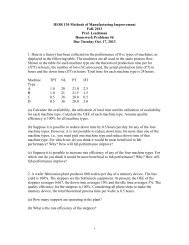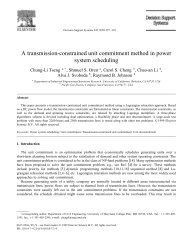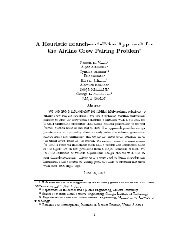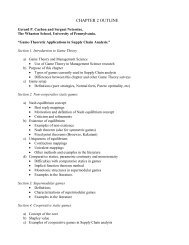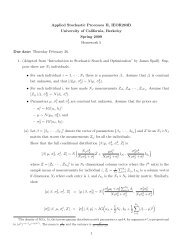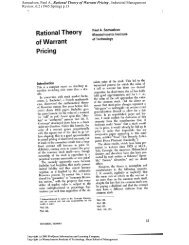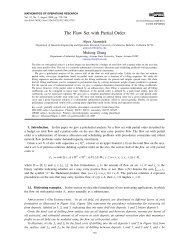Long Monotone Paths in Abstract Polytopes - University of California ...
Long Monotone Paths in Abstract Polytopes - University of California ...
Long Monotone Paths in Abstract Polytopes - University of California ...
You also want an ePaper? Increase the reach of your titles
YUMPU automatically turns print PDFs into web optimized ePapers that Google loves.
92<br />
I. ADLER AND R. SAIGAL<br />
Given a d-dimensional abstract polytope P, we def<strong>in</strong>e a sequence <strong>of</strong> dist<strong>in</strong>ct vertices<br />
v0, v, ..., v. <strong>of</strong> P as a path <strong>of</strong> length I from v0 to v1 if the vertices vi and vi+, are<br />
adjacent for each i = 0, ... , - 1. In addition, for ease <strong>of</strong> notation, by p,(v, vl) or<br />
q,(v, v1) we shall represent a specific path <strong>of</strong> length I between v and v1, and by<br />
p(v, vl) or q(v, vl) a specific path <strong>of</strong> some length between v and v1. We shall drop the<br />
subscript I on p or q whenever the length is clear from the context.<br />
Given a real valued one-to-one map 4 : P - R, and a face F <strong>of</strong> P, we def<strong>in</strong>e:<br />
(3.1) v E F as a 4)-max vertex if 0(i5) > +(v) for all v E F,<br />
(3.2) v E F as a 4-m<strong>in</strong> vertex if 0(_v) < +(v) for all v E F,<br />
(3.3) pl(vo, vl) as a 4-<strong>in</strong>creas<strong>in</strong>g path <strong>of</strong> length / if ((v0) < (vl) < ?*<br />
* < )(v); a<br />
+-decreas<strong>in</strong>g path <strong>of</strong> length I if 4(v0) > 4(vl) > ?* * > p(vl); a strict ?-<strong>in</strong>creas<strong>in</strong>g path<br />
<strong>of</strong> length 1 if it is a 4-<strong>in</strong>creas<strong>in</strong>g path and f(vi+ l) > <strong>in</strong> ((P), follow<strong>in</strong>g<br />
Klee and M<strong>in</strong>ty [5], we def<strong>in</strong>e the 4-height <strong>of</strong> P as the maximum <strong>of</strong> lengths <strong>of</strong> the<br />
various 4)-<strong>in</strong>creas<strong>in</strong>g paths <strong>in</strong> P, and the height <strong>of</strong> P as the maximum (-height <strong>of</strong> over<br />
all 4 <strong>in</strong> ?(P). Also, we def<strong>in</strong>e the strict +-height <strong>of</strong> a reversible polytope P E P(d, n)<br />
as its maximal reversible length and the strict height as the maximum strict 4)-height as<br />
4 ranges over all <strong>of</strong> ?(P). Now, by Ha(d, n) we represent the maximum height over<br />
all P <strong>in</strong> P(d, n), and Ma(d, n) as the maximum strict height as P ranges over P(d, n).<br />
Given a path p(vo, v1) <strong>in</strong> a face F <strong>of</strong> some abstract polytope P, and a vertex u <strong>of</strong><br />
some abstract polytope Q, we def<strong>in</strong>e u? p(vo, v) as the path (u, Vo), (u,<br />
v ),..., (u, v) <strong>in</strong> the face u) 0 F <strong>of</strong> Q 0 P; and p(v, vl) 0 u as the path<br />
(v0, u), (v1, u), . . , (vt, u) <strong>in</strong> the face F 0 {u) <strong>of</strong> the abstract polytope P ? Q.<br />
We now prove a lemma which establishes a result on objective functions on<br />
abstract polytopes.<br />
LEMMA. Let P E P(d, n), 4 E ?(P) with 0 < +(v) < 1 for all v E P, and Q<br />
= (u1, 2, . ., Uk} E P(2, k) (where u,, ui,+ are adjacent vectices <strong>of</strong> Q). Iff(ui), g(ui),<br />
i = 1, .. ., k, are two strict monotone sequences <strong>of</strong> real numbers with g(ui) # f(uj) for<br />
all i,j then 4(u, v) = (1 - f(v))f(u) + c(v)g(u) is <strong>in</strong> 1(Q 0 P).<br />
PROOF. Let F be a face <strong>of</strong> Q ? P. From [1], F = FQ 0 F, where FQ and Fp are<br />
faces <strong>of</strong> Q and P respectively. Let v, v, p(v, v), p(v, v) be the 4)-max, the 4f-m<strong>in</strong>, a<br />
4-<strong>in</strong>creas<strong>in</strong>g path and a 4-decreas<strong>in</strong>g path respectively <strong>in</strong> Fp. These paths exist s<strong>in</strong>ce<br />
4 E 4?(P). Also, def<strong>in</strong>e<br />
wi v if g(u,) >f(u,),<br />
= v if not.<br />
_wi= v<br />
= u if not.<br />
if g(u,) > f(ui),<br />
We now consider the three cases depend<strong>in</strong>g on whether FQ is a vertex, an edge or the<br />
whole polytope Q.




